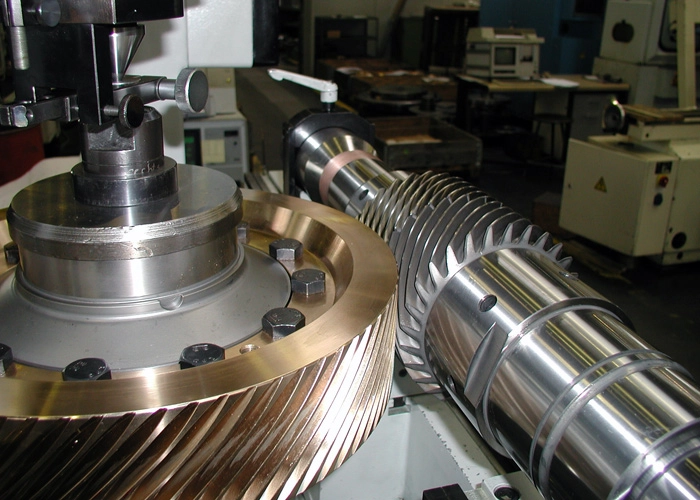Hypoid vs. Worm Gears
2024-07-18 08:52:03
In the realm of gear technology, the choice between different types of gears is crucial for achieving optimal performance in various applications. Two popular types of gears in mechanical systems are hypoid gears and worm gears. Each type offers distinct advantages and is suitable for specific applications based on efficiency, load capacity, and space requirements. This article will explore and compare hypoid and worm gears, providing a comprehensive analysis based on their design, performance, and typical applications.
Overview of Hypoid Gears

Definition and Design
Hypoid gears are a type of bevel gear where the axes of the hypoid gears do not intersect. The gear shape is hyperboloidal, unlike the conical shape of standard bevel gears. This design allows the pinion to be offset relative to the gear center, enabling more gradual engagement of the gear teeth.
- Advantages
- Increased Load Capacity: Due to the gradual engagement of the teeth and larger contact area, hypoid gears can transmit higher levels of torque and withstand greater loads.
- High Efficiency: Hypoid gears generally offer efficiencies ranging from 85% to 95%, making them suitable for applications requiring both performance and energy efficiency.
- Compact Design: The offset design of hypoid gears allows them to be used in tighter spaces, making them ideal for compact systems where space is a premium.
- Disadvantages
- Complex Manufacturing: The unique shape of hypoid gears requires more complex manufacturing processes, which can increase costs.
- Specialized Lubrication: Due to the high-pressure contact between the gear teeth, hypoid gears require high-quality, specialized lubricants.
Overview of Worm Gears
Definition and Design
Worm gears consist of a worm (similar to a screw) and a worm wheel (similar to a helical gear). The worm, which is the driving component, meshes with the teeth on the worm wheel, transmitting motion and power at generally right angles.
- Advantages
- High Reduction Ratios: Worm gears are capable of achieving high gear ratios from a single gear set, which can greatly reduce speed and increase torque.
- Self-locking Capability: Depending on the lead angle and friction, some worm gears can be self-locking, preventing backdriving, which is advantageous for safety and load holding.
- Quiet and Smooth Operation: The sliding contact between the worm and the gear wheel offers a quiet and smooth operation, ideal for noise-sensitive applications. Lunyee's PMDC Worm Gear Motor is made of durable materials, ensuring a longer service life and providing you with consistently reliable performance.
- Disadvantages
- Lower Efficiency: Worm gears typically have lower efficiencies, around 40% to 90%, due to the sliding contact between the worm and the wheel which generates heat and increases energy losses.
- Higher Wear: The sliding motion in worm gears can lead to increased wear and tear, requiring more maintenance and making them less suitable for very high-load applications.
Comparative Analysis
- Efficiency
Hypoid gears generally offer higher efficiency compared to worm gears. This makes hypoid gears more suitable for applications where energy conservation and higher power transmission are required.
- Load Capacity
Hypoid gears can handle larger loads due to the increased surface contact between the gear teeth. Worm gears, while suitable for moderate loads, may not perform as well under very high-load conditions due to the increased potential for wear and tear.
- Space Considerations
Hypoid gears are advantageous in compact systems due to their offset design, which allows them to be implemented in smaller spaces without sacrificing performance. Worm gears, while also good for compact areas, often require more space to achieve similar power transmission capabilities.
- Cost and Maintenance
Worm gears are generally simpler to manufacture and maintain but may require more frequent maintenance due to wear. Hypoid gears, while more complex and costly to produce, typically offer longer service life with less frequent maintenance, assuming proper lubrication is maintained.
- Applications
Worm gears are very suitable for space-constrained compact systems, and are widely used in conveyor belts, agricultural systems, and some self-braking mechanisms in various industries. Hypoid gears are best suited for high-torque and high-efficiency applications, and are the ideal choice for automotive drivetrain systems, heavy machinery, and energy-efficient designs that require a compact yet powerful transmission system.
Conclusion
Choosing between hypoid and worm gears depends on specific application requirements, including efficiency, load capacity, space constraints, and cost. Hypoid gears are typically favored in automotive applications, such as in rear axles of cars, where durability and efficiency are critical. Worm gears are preferred in conveyors, elevators, and various machinery where high reduction ratios and self-locking capabilities are beneficial.
See What Lunyee Can Do For You
Contact Us
- 8619149417743
- +86-0371-5562 0274
- [email protected]
- Zhengzhou, Henan Province, China
- Mon-Fri: 9:00 - 18:00




